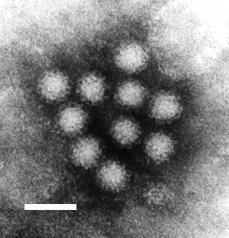
Using tracer viruses, researchers found that contamination of just a single doorknob or table top results in the spread of viruses throughout office buildings, hotels, and health care facilities.
Within 2 to 4 hours, the virus could be detected on 40 to 60 percent of workers and visitors in the facilities and commonly touched objects, according to research presented at the 54th Interscience Conference on Antimicrobial Agents and Chemotherapy (ICAAC), an infectious disease meeting of the American Society for Microbiology.
There is a simple solution, though, says Charles Gerba of the University of Arizona, Tucson, who presented the study.
“Using disinfecting wipes containing quaternary ammonium compounds (QUATS) registered by EPA as effective against viruses like norovirus and flu, along with hand hygiene, reduced virus spread by 80 to 99 percent,” he says.
Norovirus is the most common cause of acute gastroenteritis in the United States, according to the Centers for Disease Control and Prevention (CDC). Each year, it causes an estimated 19-21 million illnesses and contributes to 56,000-71,000 hospitalizations and 570-800 deaths. Touching surfaces or objects contaminated with norovirus then putting your fingers in your mouth is a common source of infection.
In the study, Gerba and his colleagues used bacteriophage MS-2 as a surrogate for the human norovirus, as it is similar in shape, size and resistance to disinfectants. The phage was placed on 1 to 2 commonly touched surfaces (door knob or table top) at the beginning of the day in office buildings, conference room and a health care facility. After various periods of time (2 to 8 hours) they sampled 60 to 100 fomites, surfaces capable of carrying infectious organisms (light switches, bed rails, table tops, countertops, push buttons, coffee pots handles, sink tap handles, door knobs, phones and computer equipment), for the phages.
“Within 2 to 4 hours between 40 to 60% of the fomites sampled were contaminated with virus,” says Gerba.
The Latest on: Spread of viruses
[google_news title=”” keyword=”Spread of viruses” num_posts=”10″ blurb_length=”0″ show_thumb=”left”]
via Google News
The Latest on: Spread of viruses
- Tick-borne Powassan virus reported in Massachusetts: ‘The virus can invade the central nervous system’on April 27, 2024 at 4:49 pm
A confirmed case of the tick-borne Powassan virus has been reported in Massachusetts, according to officials who are warning residents to take precautions against the disease.
- New federal guidelines seek to limit spread of bird flu among dairy cowson April 26, 2024 at 7:48 pm
New federal guidelines released Friday will impact Minnesota farmers, as bird flu continues to spread among dairy cows.
- Bird flu virus traces found in 1 in 5 samples of pasteurized milk: FDAon April 26, 2024 at 11:50 am
The Food and Drug Administration has found that about 1 in 5 samples of retail milk contain traces of highly contagious bird flu, though these findings may not be indicative of an infectious risk to ...
- Early test results show pasteurized milk with traces of H5N1 virus isn’t infectious, FDA sayson April 26, 2024 at 11:32 am
The US Food and Drug Administration said Tuesday that it had detected viral particles of H5N1 avian influenza in milk purchased at grocery stores, but the agency says it still believes that the milk ...
- How bird flu virus fragments get into milk sold in stores, and what the spread of H5N1 in cows means for the dairy industry and milk drinkerson April 26, 2024 at 7:18 am
The discovery of viral fragments of avian flu virus in milk sold in U.S. stores suggests that the H5N1 virus may be more widespread in U.S. dairy cattle than previously realized.
- Cacao Crisis: Devastating Virus Threatens Global Chocolate Supplyon April 26, 2024 at 7:05 am
The cacao swollen shoot virus disease can result in the loss of up to 50% of certain harvests. A swiftly spreading virus poses a risk to the health of cacao trees and the dried seeds used to make ...
- The spread of avian flu to cattle could have implications for some stockson April 26, 2024 at 4:16 am
Government health officials continue to monitor an outbreak of avian flu that has spread in the U.S. The H5N1 strain has sickened several mammals this year, according to releases from the Centers for ...
- Traces of bird flu virus have been found in milk. What's going on? Is dairy safe?on April 24, 2024 at 12:33 pm
The FDA said Tuesday that fragments of the virus that causes bird flu had been found in samples of pasteurized milk, but said milk is still safe to drink.
- USDA orders H5N1 testing of some dairy cows to limit spread of bird fluon April 24, 2024 at 11:52 am
In addition, farms that move cattle across state lines and have animals that test positive for H5N1 or any influenza A virus will be required to open their books to investigators, so they can trace ...
- Fragments of bird flu virus genome found in pasteurized milk, FDA sayson April 23, 2024 at 6:20 pm
The Food and Drug Administration on Tuesday announced that genetic fragments from the highly pathogenic avian influenza virus H5N1 have been detected in the pasteurized, commercial milk supply.
via Bing News










